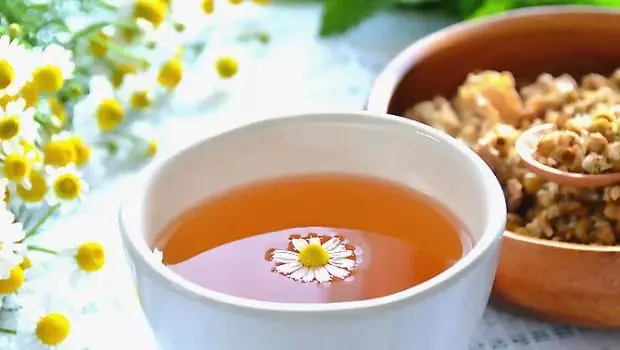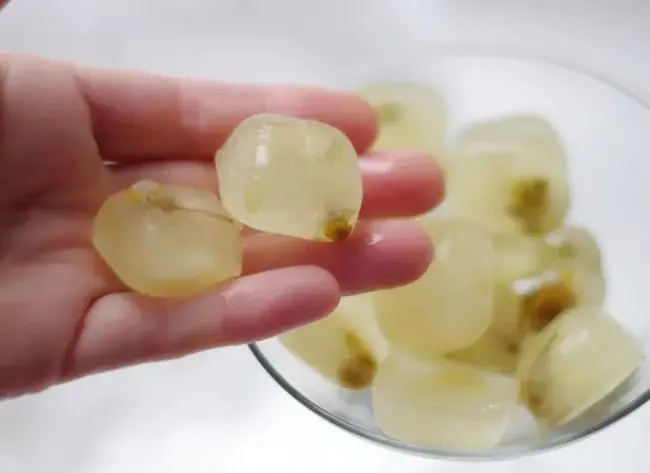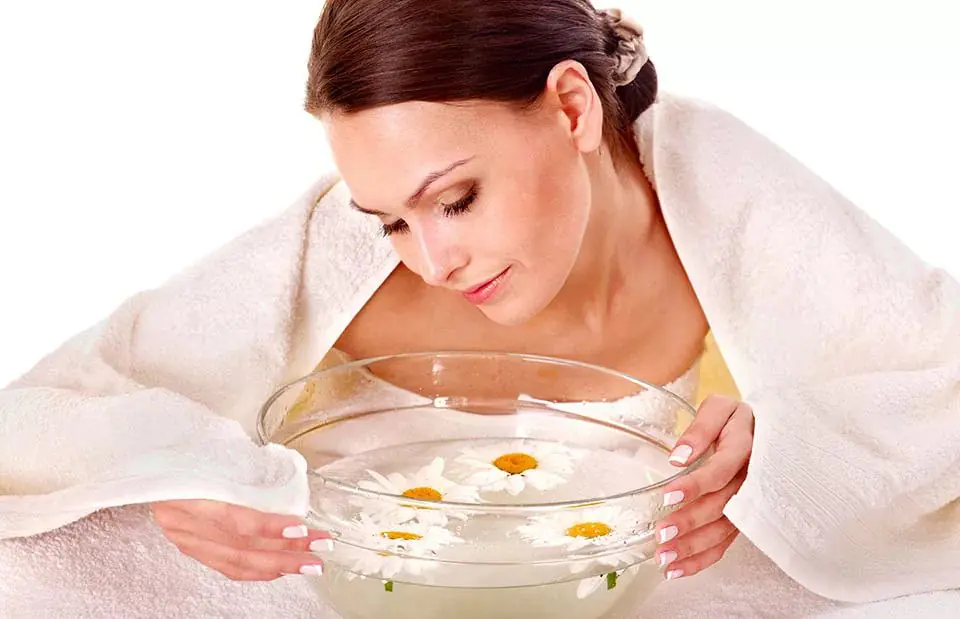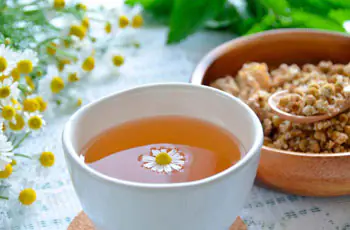A long-legged garden beauty, a shy one in the field, an inconspicuous pharmacy flower - all this is about chamomile. The plant is known for its multiple medicinal properties. Its flowers have long been used in medicinal practice. The use of chamomile for acne is recommended in both traditional medicine and folk recipes.
The use of pharmaceutical chamomile
Decorative and wildflowers are not suitable for use for medicinal purposes. Only pharmaceutical chamomile is used in various fields of medicine and many areas of industry and the national economy. The medicinal plant is characterized by a strong, unique odor and unusual appearance. Pharmaceutical chamomile is not only found growing wild, it is specially grown on plantations, since its quantity is included in the plans of the pharmaceutical and other industries for the production of medicines and consumer goods.
| Application area | Use of colors |
| Textile industry | Natural dye for wool fabrics |
| Cosmetology | The main component for children's products, creams and lotions |
| Perfume industry | Fragrance component for soap and shampoo |
| Food industry | Flavoring for special types of alcoholic products (sherry) |
| Agriculture | Component of feed for cows |
| Home pest control | Insecticide against small insects on indoor plants |
Use of the plant in medicine
The medicinal properties of the inflorescences are used in the treatment of many diseases, but few people know that the root is also useful. Powder from dry chamomile root is used for diseases of the genitourinary system, nervous disorders, allergic rashes, and acne.
| Chemical component | Effect on the body | Diseases |
| Flavonoids | Anti-inflammatory | acute respiratory infection, sore throat |
| Apiin | Antispasmodic, choleretic | Intestinal diseases, colic, flatulence |
| Organic acids | Diaphoretic, antiseptic | ARVI, flu, sore throat |
| Essential oil | Sedative | Stress, apathy, insomnia |
| Vitamin C, B4 | Tonic | Reduced immunity, seasonal depression |
Release forms and price
You can buy several types of medicinal chamomile in pharmacies:
- Flowers in filter bags (20 pieces) 60-80 rubles.
- Herb 50 g per package, 60 - 80 rubles.
- Oil extract 100 ml, 80-100 rubles.
Dry varieties are intended for preparing homemade infusions and decoctions. The liquid oil extract is used to add to medicinal baths and to make homemade cosmetics.
Inflorescences for acne treatment
The benefits of chamomile in the treatment of acne are undeniable. Acne occurs when the hormonal balance is disturbed - in adolescence, during the decline of reproductive functions, while taking hormonal drugs at any age. Acne usually occurs in places with increased sebum production - on the back, chest, scalp, and in the T-zone of the face.
For acne, it is best to use chamomile internally and externally. An integrated approach increases effectiveness while simultaneously addressing external and internal causes of the disease.
Depending on the area affected by acne and the ability to perform certain treatments on different parts of the body, chamomile for acne on the face and body is used in several forms.
Treatment of acne on the face
Treatment procedures should be started at the first small pimples, without bringing the situation to a critical point, when acne invades new areas of the skin.
Amber tea

1 tbsp. l. Brew dry inflorescences with 1 cup of boiling water, let steep for 20 minutes. You can add 1 tsp. honey Drink 30 minutes before meals. This tea can be drunk hot or cold, as it is delicious in any form. Despite the excellent taste and aroma of tea, you can drink no more than 2 cups a day for a week. Then a break is required for 14 days, after which the course can be repeated. If you are allergic to bee products, honey should not be added.
"Frosty" chamomile
Inflamed, reddened and irritated skin can benefit from rubbing with chamomile ice, which can be made from chamomile decoction. Rubbing increases blood circulation, tones the skin and has a disinfecting and disinfecting effect.
To prepare “frosty” chamomile for the face against acne, just brew a bag of pharmaceutical chamomile with 1/2 cup of boiling water and let it brew for 30 minutes. After this, pour the broth into an ice tray and freeze. You should wipe your face with an ice cube in the morning after washing your face to neutralize the effect of water. After wiping, do not wipe your face, let the healing moisture dry on the skin.
Essential oil "Chamomile"
Medicinal oil can be purchased at the pharmacy, or you can prepare it yourself: 2 tbsp. l. inflorescences pour 1/2 cup of refined (odorless) sunflower oil. Leave for 2 days. Use the oil externally, specifically lubricating large acne nodes with purulent contents, or apply a continuous thin layer to the area of skin affected by acne. Essential oil should not be taken internally when treating acne.
Chamomile infusions for acne
There are 2 ways to obtain chamomile infusions - hot and cold. It is believed that although preparing a cold infusion takes longer, it is much healthier than a hot one, since there is no heat treatment, and the medicinal components remain in full in the infusion, without evaporating when heated.
| Preparation of cold infusion | Preparation of hot infusion |
| In the evening, pour 5 teaspoons of dried inflorescences with 1 glass of boiled water at room temperature. Strain in the morning - the infusion is ready for use. |
2 tsp. pour 1.5 cups of boiling water over the flowers, strain after 20 minutes. The infusion is ready.
Any of the infusions can be taken orally 1/2 cup 2 times a day instead of amber tea, or you can use chamomile washing instead of water. Infusions can only be stored in the refrigerator for no more than 2 days.
Decoctions
When treating acne, wash with chamomile decoction and take it orally. Depending on the subsequent purpose (external or internal), decoctions are prepared in different concentrations. In both cases, it is better to prepare decoctions in a thermos - it will be faster and of better quality.
| Decoction for internal use | Pour 2 tsp into a thermos. dry inflorescences, pour 1 glass of water. Leave for 4 hours, strain. Take 1/4 cup 3 times a day instead of amber tea. |
| Decoction for external use | 3 tbsp. Place spoons of inflorescences into a thermos and add 200 ml of hot water. |
A concentrated decoction is used for compresses and lotions for acne.
Chamomile compress for inflamed acne
Soak a gauze napkin in the warm broth and apply it to your face until it cools completely. Repeat the procedure 4-5 times. It is better to apply the compress to the entire face, without specifically selecting the areas affected by acne. The compress will not harm clean skin, providing a preventive disinfecting effect. To get results, the compress must be done daily for a month. The procedure works well for ordinary rosacea, but for serious purulent nodules you need to consult a dermatologist.
Lotions
Chamomile lotions are made in the same way as a compress, only a cotton swab is used for targeted use on individual acne.
Chamomile tincture for acne
To make a tincture, add 100 ml of vodka, 2 crushed aspirin tablets to the concentrated decoction, and let it brew for 7 days. The tincture can be used for compresses and lotions for purulent, inflamed acne, since due to the alcohol base, the tincture has a more effective effect on the purulent contents, disinfecting and drying out acne. The procedure should be performed 2 times a day for a week, then repeat the course after a 10-day break so as not to dry out the skin.
Steam bath for face

A well-known procedure is chamomile inhalation for colds, when you need to breathe over a hot decoction. And before carrying out cleansing activities, you can make a chamomile facial bath to open the pores. Steaming your face is usually necessary to remove comedones (blackheads). For purulent acne, dry skin and rosacea (capillary “mesh” on the face), a steam bath should not be used. To carry out the procedure, pour the hot broth into a narrow bowl, bend over it, covered with a towel, steam your face for 10-15 minutes, then apply a film mask to remove comedones.
Mask “Glowing Skin” for blackheads
1 tsp. edible gelatin pour 1 tbsp. l. hot chamomile decoction, leave to swell. Mix with beaten egg white, apply to face in 2 layers: the first until completely dry, then the second. From the moment of application, the mask should not remain on the face for more than 20 minutes. Gently roll the chamomile face mask from bottom to top. To tighten the pores, wipe your face with a cube of “Frosty” chamomile.
Treatment of acne on the body
Acne on the back and chest usually occupies large areas. Features of the treatment are the inaccessibility of the back areas and the possibility of treatment only at night, so in this case chamomile baths are often recommended.
When treating acne on the body, the following is used:
- amber tea for oral administration;
- “Frosty” chamomile for wiping the affected areas on the chest;
- Chamomile essential oil for lubricating acne.
In addition to these procedures, the “Chamomile Field” medicinal bath is recommended. Taking a bath guarantees disinfection of all hard-to-reach areas and a drying effect.
Therapeutic bath “Chamomile field”

For acne on the body (chest, back), you can take chamomile baths. To do this, you need to prepare a strong chamomile infusion: pour 2 packs of flowers with 1 liter of boiling water, let it brew for half an hour. Strain, pour into a bath with water no higher than 38 degrees. If you don’t have time to brew the inflorescences, you can buy chamomile extract at the pharmacy for 80 rubles per 100 ml. Pour 50 ml of extract into a standard bath. Take a bath for no longer than 20 minutes. After the procedure, it is advisable not to wipe the body, but to let the skin dry. The procedure should be carried out before bedtime, as it causes drowsiness. After the bath, you can apply essential oil to your skin. Do the procedure every other day, the course of treatment is 10 sessions.
Chamomile face masks
Chamomile masks are very useful for inflamed facial skin with acne, as they have the following effect on the skin: [su_list icon=»icon: check-square-o» icon_color=»#aa2a88″]
- regulate the functioning of the sebaceous glands, reducing the production of sebum; have a mattifying effect (remove oily sheen);
- influence regenerative processes, eliminating scars and acne scars;
- whitens post-acne pigmentation.[/su_list]
Kaolin-chamomile mask
Dilute a bag of cosmetic white clay with 1/2 cup of warm broth. Apply the mixture to cleansed skin using massaging circular movements, avoiding the orbital area around the eyes. After 15 minutes, wash your face and wipe your face with a “Frosty” chamomile cube. The mask exfoliates dead epithelial particles well, cleanses pores and relieves inflammation, used once a week.
Mask “Black Chamomile”
2 tsp. Dilute black clay with a decoction to a pasty state and apply to the face. After 20 minutes, rinse off and wipe your face with chamomile to neutralize the effect of water. The mask improves turgor and normalizes metabolic processes in the epidermis. The procedure can be carried out once every 10 days.
Reviews about acne treatment
There is no clear answer to the question of whether chamomile helps with acne. Reviews from some users confirm the healing effect of the plant against acne, while others say the opposite. How effective chamomile will be for acne largely depends on the severity of the dermatological disease and the reasons that caused it.
At any age, acne on the face is a very unpleasant acquisition, often annoying not only physically, but also aesthetically. Cosmetologists advise taking all measures to get rid of them, because formations left unattended lead to the growth of the affected area and penetration of infection into deeper layers. This often results in serious and lengthy treatment by a dermatologist and the need for plastic surgery. A very effective and easily accessible remedy for the treatment of affected facial skin is chamomile.
Content:
- Why does chamomile help with acne?
- How to use chamomile
- If you need to quickly relieve inflammation
- To make the effect of acne treatment with chamomile last longer
- Contraindications

Why does chamomile help with acne?
Chamomile has properties that help get rid of existing acne on the face and prevent the appearance of new ones:
- Antibacterial. Microbes and bacteria are the main culprits in the appearance of acne of various types on the skin. If you get rid of them, the number of existing ones will significantly decrease and the appearance of new formations will stop.
- Anti-inflammatory. Pimples and ulcers are always accompanied by inflammation of the skin around them. Chamomile relieves these inflammations, visibly brightens them, and soothes the skin.
- Regenerating. Restores the epidermis in acne-affected areas, evens out color, stimulates metabolic processes, which speeds up healing.
- Regulating sebum secretion. Excessive sebum clogs the pores, leading to the formation of pimples and blackheads. Normalizing its secretion significantly reduces their number.
How to use chamomile
At home, to care for acne-prone skin, you can prepare chamomile infusion, ice cubes, hydrosol, and oil. The pharmacy sells a more concentrated substance - chamomile essential oil. Each of these remedies is very effective and promises positive results if used correctly.
Chamomile infusion for acne
Chamomile infusion for acne on the face is prepared according to the standard recipe indicated on the package: 2 tbsp. l. raw materials are poured with boiling water, infused and filtered. From the warm infusion, you can make compresses daily on the affected areas of the skin to relieve inflammation, lighten them slightly, and speed up healing. Carry out the procedure as needed. After finishing, lubricate the skin with day cream. The frozen infusion can be used for washing. It tones, improves blood circulation, tightens pores, stimulates the secretion of sebum.
The most effective will be alternating warm infusion and cold cubes in caring for a face affected by acne. In the morning it is better to use cubes to “wake up” the skin and all processes in it. In the evening, a warm decoction will relieve fatigue and cleanse you of impurities.
Chamomile hydrolate (chamomile water)
A more effective chamomile remedy for caring for inflamed skin is hydrolate. This is a concentrated liquid collected by passing steam through plant materials. It contains the maximum amount of useful substances necessary to quickly improve the condition of the skin. Hydrolates have the properties of essential oils, but are less aggressive than them. Therefore, they are often used to treat sensitive skin.
Place the steamer with the herbs in a saucepan of water. Place a container on the raw material where the condensate will drain. Cover the pan with an inverted lid and place on low heat. To make the steam that collects on the lid quickly turn into water and flow into the container, pour cold water into the lid. The process will take several hours. Pour the finished hydrosol into a glass container with a tight lid and store in the refrigerator for no more than six months.
Hydrolate is used as an independent means for wiping the skin, in the form of lotions and compresses, and added to creams and lotions.
Video: Chamomile hydrolate at home
Chamomile oils
Chamomile oil based on a vegetable (olive, sunflower) or aromatic base (wheat germ, almond) can be used for skin smoothing and acne-relieving masks. To prepare it, bring 100 ml of oil to a boil in a water bath. Add ½ cup of chamomile infusion and simmer for 15 minutes. Cool the finished mixture and put it in the refrigerator.
The oil can be used instead of a daily cream. It is better to apply it in the evening, removing any residue after 15-20 minutes. During the day it is too noticeable, and made on the basis of vegetable oil it has a rather characteristic food smell. It is necessary to remove residues so that they do not clog pores or provoke the opposite effect to the expected one. After all, clogged pores are the first step towards the accumulation of dirt and sebum in them, which leads to the formation of acne.
Video: How to make chamomile oil
Essential oil
Chamomile essential oil is a more concentrated facial skin care product. It should be used very carefully, making sure to test for an allergic reaction. The oil can be added to daily creams, lotions and tonics (2-3 drops per single dose), to baths for washing and bathing (6-8 drops per bath).
If you need to quickly relieve inflammation
If a pimple that suddenly appears is very noticeable and spoils your mood, you should not despair. With the help of chamomile, you can relieve inflammation and significantly lighten the reddened area of the skin. To do this, add a little white clay or a couple of crushed aspirin tablets to a freshly prepared chamomile infusion until a thick paste forms. Apply the mixture to the affected area and leave for 15-20 minutes. Rinse off with warm water.
To make the effect of acne treatment with chamomile last longer
Most acne is not a dermatological problem. Their appearance is a consequence of diseases. Therefore, in parallel with the external influence of the medicinal plant, you should treat all your internal problems, even if they do not yet manifest themselves. In women, the cause of acne is most often problems associated with endocrinology, gynecology and gastroenterology.
If the body takes herbal teas, then you can enhance the effect of chamomile by drinking a tablespoon of the herb brewed with a glass of boiling water twice a day. If you don’t really like the taste, you can add a teaspoon of honey.
Contraindications
Chamomile is considered a mild herb, hypoallergenic, intended to care even for sensitive children's skin. However, it also has some contraindications for use:
- Chamomile is not recommended for individual intolerance.
- Chamomile ice should not be used for rosacea, spider veins, or a tendency for blood to flow to the face.
- Alcohol infusions of chamomile are contraindicated for acne-plagued skin. Alcohol is a stress drug; it does more harm to problem skin than good, damaging its natural protective mantle.
Medical expert article
An effective remedy for combating skin problems is chamomile. For acne, it is used in the form of solutions, lotions, infusions, masks and even ice cubes.
Poor nutrition, polluted environment, medications and many other factors actively affect our skin. They increase the activity of the sebaceous glands, exposing the skin to additional stress. Because of this, people of any age experience acne, but most often teenagers during the period of hormonal changes.
Acne is a non-medical term, as the meaning of this problem is too vague. There are the following types of acne (pimples):
- A comedon (white pimple) is a sebaceous plug that clogs a pore and causes an inflammatory process. Very often, comedones are called blackheads, since the black color indicates oxidized sebum on the surface of the pimple. If it appears in the upper part of the pore, then it is an open comedon; closed comedones are localized deep in the pores. If an infection penetrates into a closed one, this leads to the development of a papule.
- A papule is an inflammatory and painful neoplasm. Its color ranges from red to bluish, but when pressed it turns pale.
- Pustule - has purulent contents, which manifests itself as a white dot on the surface of the formation.
- Nodular cystic acne is one of the forms of pustules. They penetrate deep into the dermis and form conglomerates. Connected by fistulous ducts.
- Fulminans are a severe form of acne. It manifests itself in large areas with acne, hyperthermia, pain in bones and muscles, and changes in the leukocyte form. The disease has several stages.
Chamomile (Matricaria) has pronounced anti-inflammatory and antiseptic properties. Thanks to this, it copes well with acne on the face and body. The plant disinfects and relieves inflammatory processes, improves metabolic processes in tissues, saturates the skin with useful substances, moisturizes, and stimulates the regeneration processes of damaged tissues.
Does pharmaceutical chamomile help with acne?
The effectiveness of chamomile in treating acne is based on its beneficial properties:
- Antibacterial – In most cases, acne is caused by germs and bacteria. The plant destroys pathogens and reduces skin rashes.
- Anti-inflammatory – acne and purulent formations are accompanied by inflammatory reactions. Chamomile relieves inflammation, soothes and brightens the skin.
- Regulating sebum production – increased sebum production leads to the appearance of pimples and blackheads. The plant normalizes secretion and reduces the amount of acne.
- Detoxifying – herbal remedy absorbs cellular metabolic products and toxins.
- Regenerating – accelerates the processes of restoration of damaged tissues. Stimulates local metabolic processes, facilitating the healing process.
In most cases, the appearance of acne is not caused by dermatological problems, but by various diseases of the body. For complex treatment of a cosmetic defect, not only external effects are indicated, but also the elimination of internal problems. The latter include endocrine pathologies, gynecological, and gastroenterological disorders.
[1]



